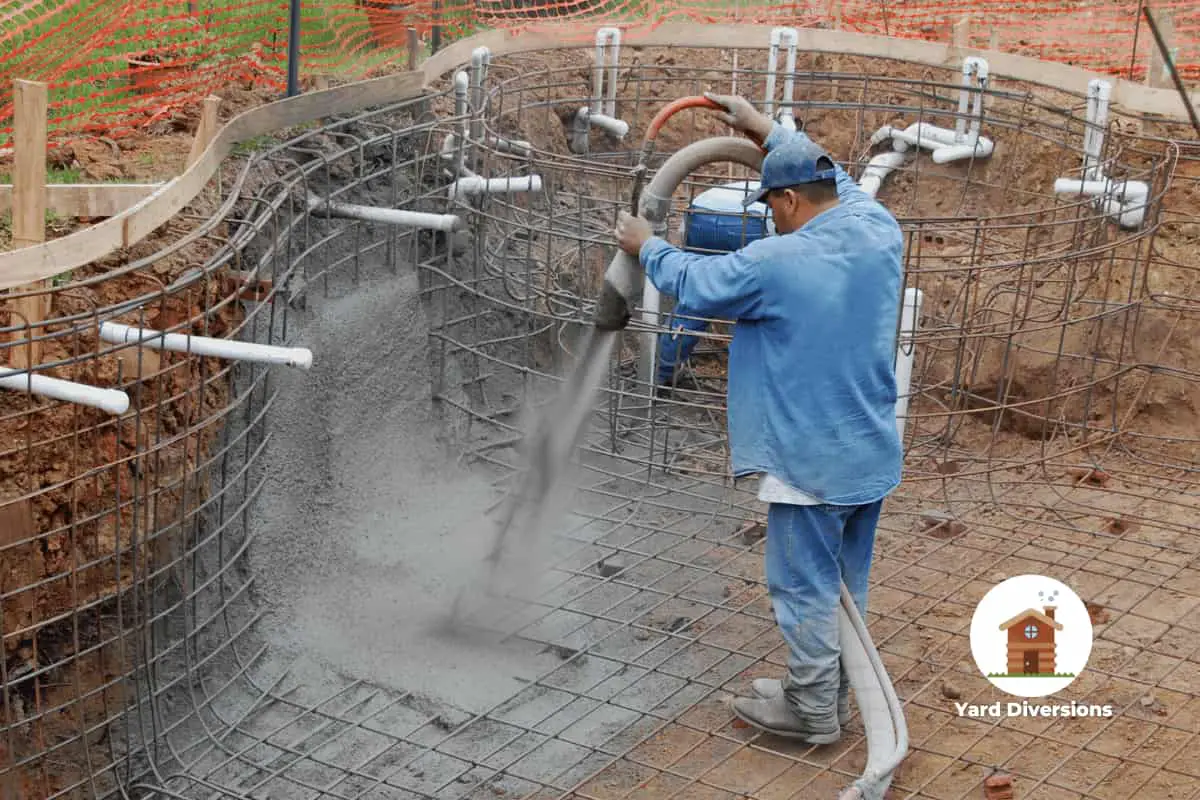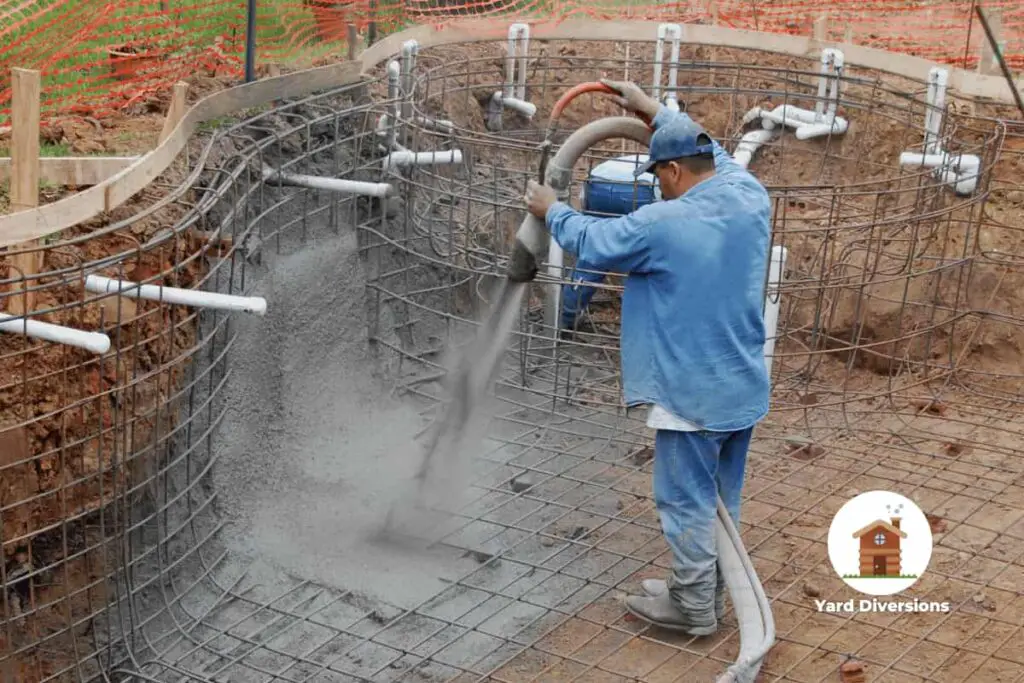Are you considering having a pool installed in your backyard? With so many options available, deciding which material is suitable for you can be overwhelming.
This blog post will help you make that decision by looking at the pros and cons of fiberglass and concrete pools. Read on to learn more!

Introduction
The topic of fiberglass versus concrete pools can be daunting, and with both options having pros and cons, it can be hard to decide which is the best for your backyard.
Today we’ll explore the differences between fiberglass and concrete pools in terms of cost, installation process, comfort, and more.
We’ll also provide helpful tips on maintaining both types of pools to last a long time, and look at all the information provided here to make an informed decision about which pool is right for you!
Cost of Installation
The installation cost for a fiberglass pool is typically cheaper than that of a concrete or Gunite pool, with the average cost ranging from $20,000 to $40,000.
On the other hand, installing a concrete pool can be more expensive due to the complexity of the process and the labor costs associated with it.
The pouring of concrete, fencing, and decking can all add to the overall cost. Installation time is also an essential factor to consider when deciding between the two types of pools.
Fiberglass pools are usually much quicker to install and require less labor, while concrete pools will take longer due to the complexity of the process.
Cost of Materials
Regarding the cost of materials, fiberglass and concrete pools are comparable in price.
- Fiberglass pools cost between $20,000 and $85,000, with an average cost of around $52,500.
- Concrete pools tend to be slightly more expensive initially, with an average cost of between $30,000 and $100,000.
The main cost difference comes from the additional fencing and decking added to the installation process.
These costs can add up to an additional $10,000 or more on top of the cost of the pool itself.
The good news is that DIY installations can be a more budget-friendly option regarding fiberglass pools.
Labor Cost for Installation
When it comes to the labor cost for the installation of a fiberglass or concrete pool, there is a significant difference between the two.
The labor cost for installing a fiberglass pool is about $5.50 per square foot, and for a concrete pool, it is around $7.50 per square foot.
While the cost of materials may vary depending on the pool size, the labor cost remains relatively similar.
The installation process for both pools requires a five-person crew and around 160 labor hours, so that the labor cost can be pretty high.
It’s important to remember that while fiberglass pools may be initially cheaper to purchase, the labor costs associated with installation will make up the difference in the total price.
Time Required for Installation
Regarding installation time, fiberglass pools are much quicker to install because the pool is already made in the factory and only needs to be placed in the chosen area.
On average, fiberglass pools take days or weeks to install, while on the other hand, concrete (gunite) pools take weeks to months to build as all of the work is done on-site.
Homeowners who want to save money on their fiberglass pool can opt for a self-install or DIY package, which typically includes the pool shell and other necessary components.
Maintenance Costs
When it comes to maintenance costs, fiberglass and concrete pools differ significantly.
Generally, fiberglass pools are much cheaper to maintain than concrete or Gunite pools.
This is because fiberglass is more resistant to staining and algae growth and requires less chlorine than other pool types to stay clean.
The 10-year maintenance cost of a fiberglass pool ranges from $3,500 to $4,500, while the 10-year maintenance cost of a concrete pool ranges from $7,000 to $12,000.
Concrete pools require acid washing every 3-5 years and resurfacing every 8-10 years, while fiberglass pools require liner replacements every 2-3 years.
Fiberglass is your best bet if you’re looking for a pool that won’t break the bank regarding maintenance costs.
Longevity
The longevity of a pool is an essential factor to consider when deciding which type to install.
Concrete, marcite, or gunite pools typically last 10 to 15 years, while fiberglass pools can last 25 years or more with minimal maintenance.
If you’re looking for a longer-term investment in your backyard, a fiberglass pool may be your best choice.
However, regular maintenance and cleaning are essential for both types of pools to ensure their longevity.
With proper care and upkeep, you will be able to enjoy your pool for many years to come.
Comfort
When it comes to comfort, fiberglass and concrete pools, both offer advantages and disadvantages.
Fiberglass pools provide a smooth, non-abrasive surface that is comfortable to touch and walk on, but they can become slick if not treated with a non-skid coating.
Concrete pools have the advantage of being highly customizable, but the rough surface can be abrasive on bare feet.
Ultimately, it comes down to personal preference, as both pool surfaces can be enjoyable with proper care and maintenance.
Installation Process
The installation process is essential in choosing between fiberglass and concrete pools.
Concrete pools require onsite construction, which can take anywhere from three to six months to finish, while fiberglass pools are factory-made and can be installed in a matter of days.
In addition, fiberglass pools come with a gel coating which gives them a smooth finish and requires less maintenance than concrete pools.
However, concrete pools offer more flexibility in shape and size and can be customized to fit any backyard.
Regardless of the type of pool you choose, it is crucial to understand the installation process to make an informed decision.
Heating Up and Retaining Heat
When comparing fiberglass and concrete pools, heating up and retaining heat are two key factors.
Fiberglass pools heat up quicker and retain heat longer than concrete pools because their shells and liners are thinner.
The thin, non-heat absorbent material of the shell and liner allows the pool to heat up faster while retaining the heat for extended periods.
This makes them an excellent choice for those who want to enjoy their pool all year round without having to reheat it constantly.
Additionally, because fiberglass pools tend to be smaller than concrete pools, you can more efficiently heat the water in a shorter amount of time.
What Are the Maintenance Costs for Fiberglass Pools Compared to Concrete Pools?
fiberglass pool installation costs & maintenance tend to be lower compared to concrete pools. While fiberglass pools require less regular maintenance such as resurfacing or repainting, concrete pools often demand extensive upkeep. Maintenance costs for fiberglass pools typically involve routine cleaning, water balancing, and occasional filter replacement. Overall, opting for a fiberglass pool can offer a cost-effective and hassle-free swimming experience.
Cleaning and Maintenance
Cleaning and maintenance are two important factors when deciding between a fiberglass and a concrete pool.
Fiberglass pools are easier to clean than concrete pools because of their smooth, non-porous surface.
This type of surface eliminates the likelihood of algae or bacteria growth, helping to ensure the water is safe.
Fiberglass pools also have low maintenance costs, requiring fewer chemical treatments and less frequent resurfacing than a concrete pool.
On the other hand, concrete pools require regular resurfacing every 7-10 years and more frequent chemical treatments to prevent algae growth.
Both pools will require regular cleaning and maintenance, regardless of which type you choose.
Cleaning a Fiberglass Pool
Cleaning a fiberglass pool is relatively easy and requires less maintenance than a concrete or vinyl liner pool.
Fiberglass pools are made from a smooth, non-porous material, so there is less chance for algae and bacteria to grow.
Cleaning a fiberglass pool requires less labor and fewer chemicals than concrete pools.
Because the finished gel coat surface is extraordinarily smooth and non-porous, the pool needs little brushing to keep it free of debris and other materials.
Cleaning can be done with a brush and vacuum regularly, but it usually only needs to be done once or twice weekly.
Cleaning a Concrete Pool
Cleaning a concrete pool is a more labor-intensive task when compared to cleaning a fiberglass pool.
Concrete pools require frequent vacuuming and brushing because of the porous surface, which can lead to the growth of algae and bacteria.
In addition, the walls and floor of a concrete pool need to be scrubbed regularly with a special brush to remove any build-up of debris or contaminants.
Furthermore, chemicals must be added regularly to keep the pool clean and safe for swimming. However, if these steps are taken, a concrete pool can remain clean and well-maintained.
Maintenance of Fiberglass and Concrete Pools
Regarding maintenance, fiberglass and concrete pools are relatively easy to care for.
Fiberglass pools are typically lower maintenance as they have a durable and smooth finish resistant to algae and chemical damage.
This makes them easier to clean as there is nowhere for algae to take hold.
Concrete pools are more expensive to install and require less regular maintenance than other pools.
However, they need to be resurfaced every 10-12 years, and the liner may need replacing every 5-7 years, depending on the conditions of the pool.
For both fiberglass and concrete pools, regular chemical balancing, cleaning of filters and skimmers, and vacuuming of the pool are essential for proper care.
Should I Choose Fiberglass or Concrete for My Above Ground Pool to Avoid Structural Issues?
When deciding between fiberglass or concrete for your above ground pool, consider the reasons for bowing above ground pool. Fiberglass pools are less prone to structural issues like bowing due to their flexibility, making them a better choice for long-term durability. Consider this before making your decision.
Conclusion
When choosing the best pool for your backyard, there are a few things to consider.
Both fiberglass and concrete pools offer advantages and drawbacks, so it’s crucial to weigh the pros and cons of each before making a decision.
Fiberglass pools are generally easier to install and maintain, more comfortable to walk on than concrete and require less energy and chemical usage.
On the other hand, concrete pools are more customizable, offer more durability, and can last 20 years or more with proper maintenance.
Ultimately, both pools offer excellent options for people looking to make a significant investment in their home.


